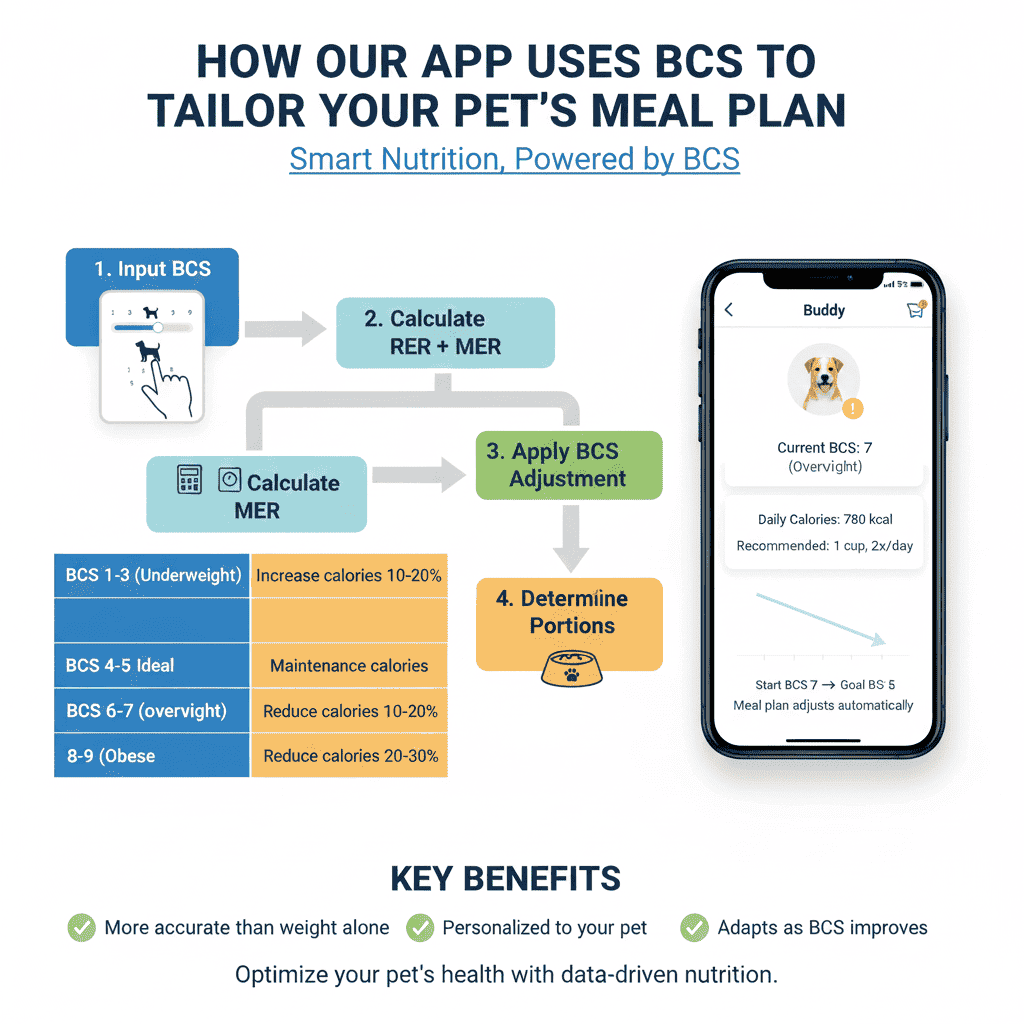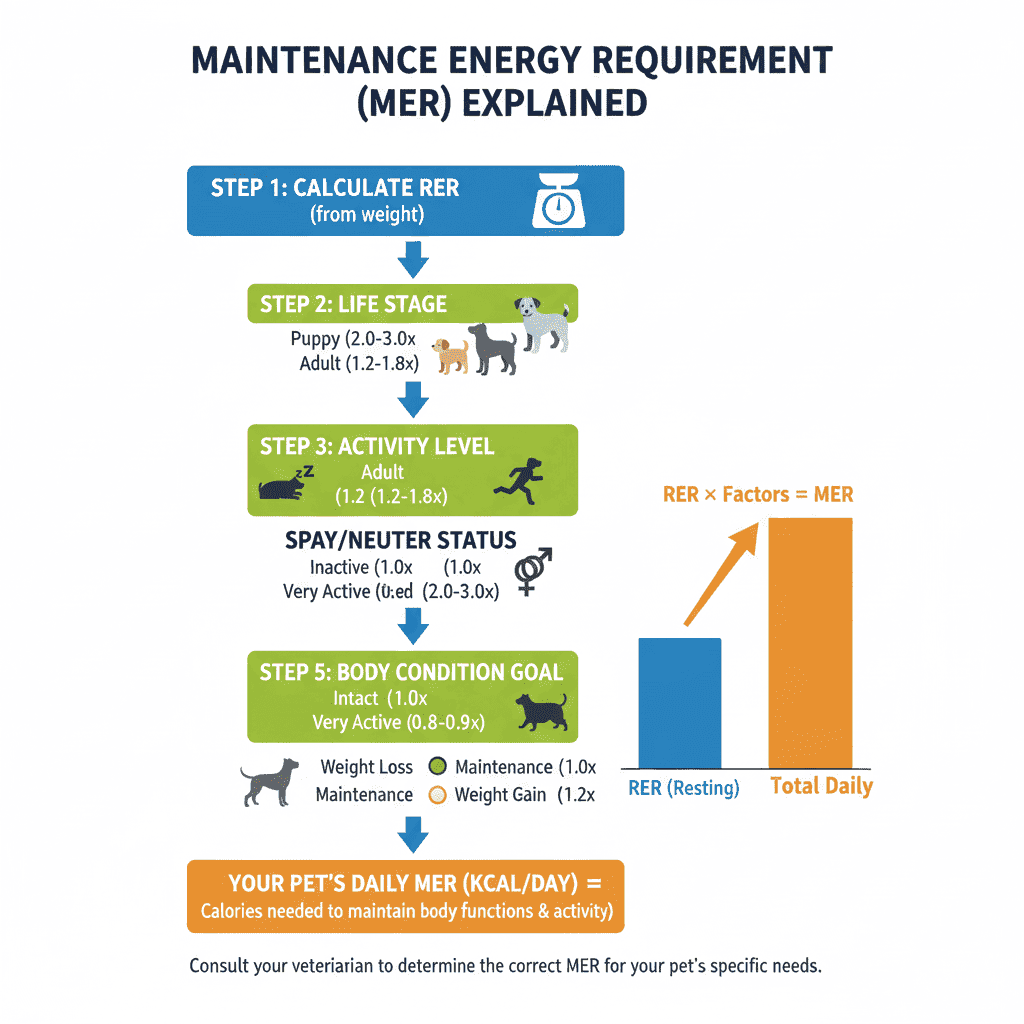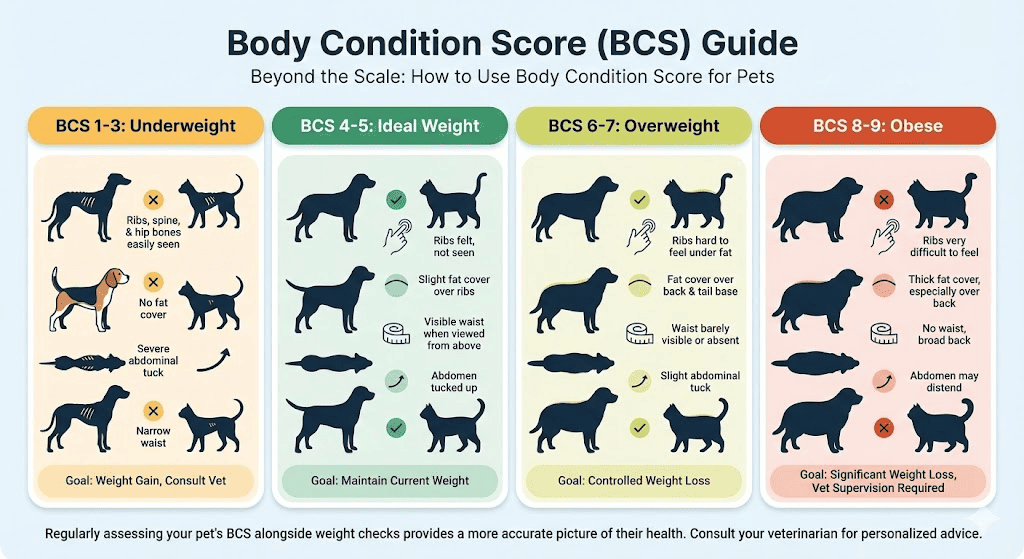You've learned how to assess your pet's Body Condition Score (BCS)—feeling for ribs, checking the waist, observing the abdominal tuck. But knowing your pet's BCS is only the first step. The real power comes from using that information to create a precise, personalized meal plan that helps your pet achieve and maintain their ideal body condition.
At PetMealPlanner, Body Condition Score isn't just a number we collect—it's the foundation of our entire meal planning system. It's how we ensure your pet gets exactly the right amount of food for their current condition and their goals.
Why BCS is the Foundation of Our System
Traditional feeding methods rely on weight alone, which is inherently flawed. Two pets can weigh exactly the same but have completely different body compositions—one might be perfectly healthy while the other is dangerously overweight or underweight.
BCS solves this problem by:
- Assessing actual body composition (fat vs. muscle)
- Accounting for frame size and breed differences
- Providing a standardized, objective measure
- Giving us precise information to calculate calorie needs
This is why BCS is the first thing we ask about when you set up your pet's profile. It's not optional—it's essential.

How We Use BCS in Our Calculations
Step 1: Initial Assessment
When you input your pet's Body Condition Score, our system immediately understands:
BCS 1-3 (Underweight):
- Your pet needs to gain weight
- Current calorie intake is likely insufficient
- We'll calculate calories for healthy weight gain
- Goal: Reach BCS 4-5 (ideal weight)
BCS 4-5 (Ideal Weight):
- Your pet is at their target body condition
- We'll calculate maintenance calories
- Goal: Maintain current condition
BCS 6-7 (Overweight):
- Your pet needs to lose weight
- Current calorie intake is likely excessive
- We'll calculate calories for safe weight loss
- Goal: Reach BCS 4-5 (ideal weight)
BCS 8-9 (Obese):
- Your pet needs significant weight loss
- Requires more aggressive calorie reduction
- We'll calculate calories for structured weight loss
- Goal: Reach BCS 4-5 (ideal weight)
Step 2: Calorie Adjustment Based on BCS
Our system applies specific multipliers based on your pet's BCS:
For Weight Loss (BCS 6-9):
- BCS 6-7 (Overweight): Reduce calories by 10-20% from maintenance
- BCS 8-9 (Obese): Reduce calories by 20-30% from maintenance
For Weight Maintenance (BCS 4-5):
- BCS 4-5 (Ideal): Use standard maintenance calories (no adjustment)
For Weight Gain (BCS 1-3):
- BCS 1-3 (Underweight): Increase calories by 10-20% from maintenance
Step 3: Integration with RER and MER
BCS works in combination with our RER (Resting Energy Requirement) and MER (Maintenance Energy Requirement) calculations:
- We calculate RER first using your pet's current weight
- We calculate MER by applying life stage, activity, and spay/neuter factors
- We adjust MER based on BCS to account for weight goals
- We determine precise portions based on your chosen food's calorie content
This multi-layered approach ensures accuracy at every step.
Real-World Example: How It Works
Let's walk through an example:
Scenario: Overweight Dog Needs to Lose Weight
Pet Profile:
- 50-pound adult spayed dog
- BCS 7 (Overweight)
- Moderate activity level
- Goal: Reach BCS 5 (Ideal weight)
Our Calculation Process:
-
Calculate RER:
- Weight: 50 lbs = 22.7 kg
- RER = 70 × (22.7)^0.75 = 794 calories
-
Calculate Base MER:
- Life stage (adult spayed): 1.5×
- Activity (moderate): 1.5×
- Base MER = 794 × 1.5 × 1.5 = 1,786 calories
-
Apply BCS Adjustment:
- BCS 7 = Overweight, weight loss goal
- Adjustment: 0.85× (15% reduction)
- Adjusted MER = 1,786 × 0.85 = 1,518 calories/day
-
Determine Portions:
- If food has 400 kcal/cup
- Portion = 1,518 ÷ 400 = 3.8 cups/day
Result: Your pet gets a precise meal plan designed to help them lose weight safely while maintaining muscle mass.
Dynamic Adjustments: How BCS Changes Over Time
Your pet's BCS isn't static—it changes as they progress toward their goals. Our system is designed to adapt:
Monthly Reassessment
We recommend reassessing your pet's BCS monthly (or more frequently during active weight management). When you update your pet's BCS:
If BCS Improves:
- System automatically adjusts calorie targets
- Portions may increase (if moving from underweight to ideal)
- Portions may decrease (if moving from overweight toward ideal)
- New meal plan generated based on updated condition
If BCS Stays the Same:
- System maintains current plan
- May suggest adjustments if progress stalls
- Provides guidance on next steps
If BCS Worsens:
- System identifies the issue
- Recommends veterinary consultation
- Suggests plan adjustments
- Provides troubleshooting guidance
Progress Tracking
Our system tracks your pet's BCS over time, showing you:
- Starting BCS: Where your pet began
- Current BCS: Where they are now
- Target BCS: Where they're going (always 4-5, ideal weight)
- Progress timeline: How long it's taking
- Projected completion: When they might reach goal
Why This Approach Works Better
Traditional Methods vs. BCS-Based Planning
Traditional (Weight-Based) Method:
- ❌ Doesn't account for frame size
- ❌ Ignores body composition
- ❌ Can't distinguish muscle from fat
- ❌ One-size-fits-all approach
- ❌ Often leads to overfeeding or underfeeding
BCS-Based Method (Our Approach):
- ✅ Accounts for individual body composition
- ✅ Works for all breeds and sizes
- ✅ Distinguishes between muscle and fat
- ✅ Personalized to each pet
- ✅ Precise calorie calculations
The Science Behind It
Our BCS-based approach is grounded in veterinary science:
- Veterinary standard: BCS is the gold standard used by veterinarians worldwide
- Research-backed: Studies show BCS is more accurate than weight alone
- Proven effective: Used successfully in veterinary weight management programs
- Objective measure: Reduces guesswork and subjectivity
Special Features: BCS-Specific Guidance
For Overweight Pets (BCS 6-9)
Our system provides:
- Safe weight loss targets: 1-2% of body weight per month
- Muscle preservation: Ensures adequate protein during weight loss
- Progress monitoring: Tracks weight loss and BCS improvement
- Adjustment recommendations: When to increase or decrease calories
- Veterinary consultation reminders: When professional guidance is needed
For Underweight Pets (BCS 1-3)
Our system provides:
- Healthy weight gain targets: Gradual, controlled increases
- Calorie-dense options: Foods that help gain weight safely
- Medical screening reminders: Underweight can indicate health issues
- Progress monitoring: Tracks weight gain and BCS improvement
- Veterinary consultation recommendations: Always recommended for underweight pets
For Ideal Weight Pets (BCS 4-5)
Our system provides:
- Maintenance calculations: Precise calories to maintain condition
- Monitoring recommendations: How often to reassess
- Adjustment triggers: When to modify the plan
- Prevention guidance: How to prevent future weight issues
Integration with Other Factors
BCS doesn't work in isolation—it integrates with all the other factors we consider:
Life Stage
- Puppies/Kittens: BCS helps ensure healthy growth (not too fast, not too slow)
- Adults: BCS guides maintenance feeding
- Seniors: BCS accounts for age-related body composition changes
Activity Level
- Active pets: May have lower BCS due to muscle mass (we account for this)
- Sedentary pets: May have higher BCS due to excess fat (we adjust accordingly)
Spay/Neuter Status
- Sterilized pets: More prone to weight gain (BCS helps catch this early)
- Intact pets: May have different body composition (BCS accounts for this)
Health Conditions
- Some conditions affect BCS: We consider this in our calculations
- Medications may affect weight: BCS helps monitor these effects
- Recovery from illness: BCS guides nutritional support
Getting Started: How to Use BCS in Our App
Step 1: Assess Your Pet's BCS
Use our guides to perform a BCS check:
- How to Perform a Body Condition Check on Your Dog at Home
- How to Perform a Body Condition Check on Your Cat at Home
Step 2: Input BCS in Our App
When setting up your pet's profile:
- Navigate to the body condition section
- Select your pet's current BCS (1-9 scale)
- Our system automatically uses this in all calculations
Step 3: Get Your Personalized Meal Plan
Our system:
- Calculates RER based on weight
- Calculates MER with all factors
- Applies BCS adjustments
- Determines precise portions
- Provides your complete meal plan
Step 4: Monitor and Update
- Reassess BCS monthly (or as recommended)
- Update BCS in the app when it changes
- System automatically adjusts your meal plan
- Track progress over time
Tips for Best Results
Accurate BCS Assessment
- Learn the technique: Use our step-by-step guides
- Practice regularly: You'll get better with time
- Get veterinary confirmation: Have your vet verify your assessment
- Be honest: Accurate BCS leads to better results
Regular Updates
- Update monthly: During weight management programs
- Update quarterly: For pets at ideal weight
- Update when circumstances change: Activity, health, life stage changes
Patience and Consistency
- Weight changes take time: Healthy changes are gradual
- Stick to the plan: Consistency is key
- Trust the process: BCS-based planning works
- Celebrate progress: Even small improvements matter
The Bottom Line
Body Condition Score is the foundation of our entire meal planning system. It's how we ensure your pet gets precisely the right amount of food for their current condition and their goals.
Why this matters:
- More accurate than weight alone
- Personalized to your individual pet
- Based on veterinary science
- Proven effective for weight management
- Adapts as your pet progresses
When you use PetMealPlanner, you're not just getting generic feeding recommendations—you're getting a scientifically-based, personalized meal plan that uses the same assessment methods veterinarians use worldwide.
Ready to create a BCS-based meal plan for your pet? Start planning now and discover the power of personalized nutrition.
For more information on Body Condition Scoring, see our comprehensive guides:


